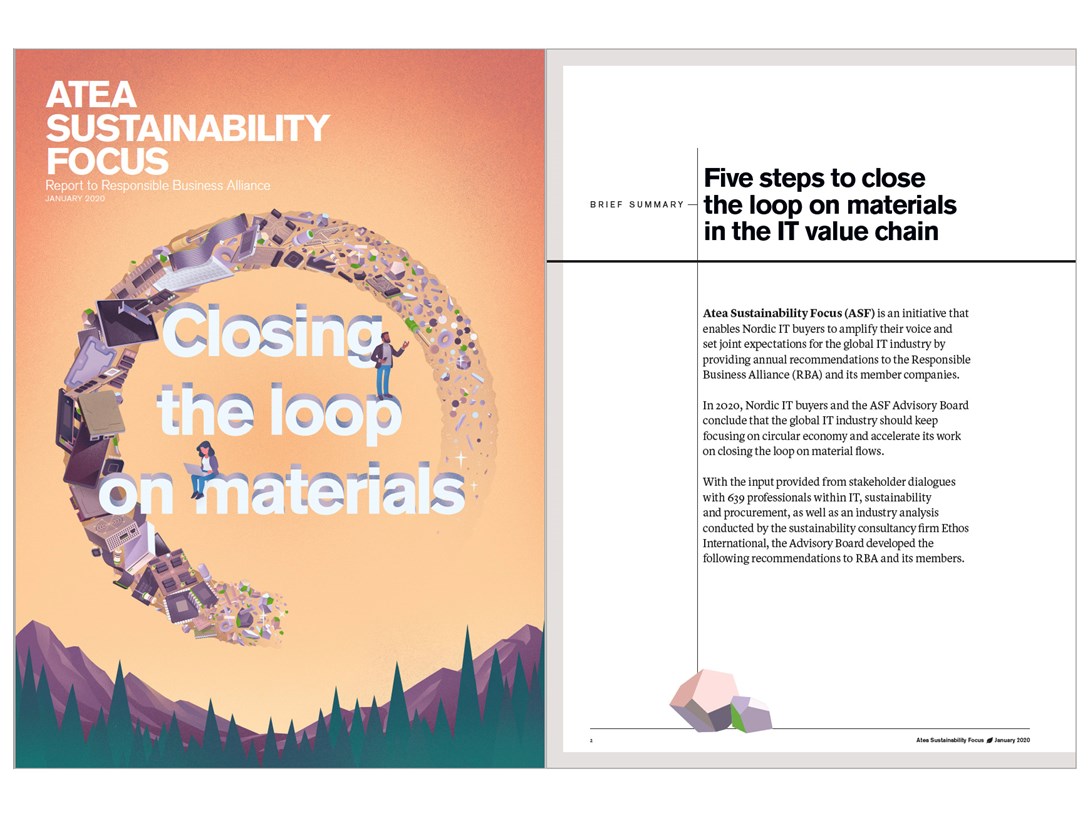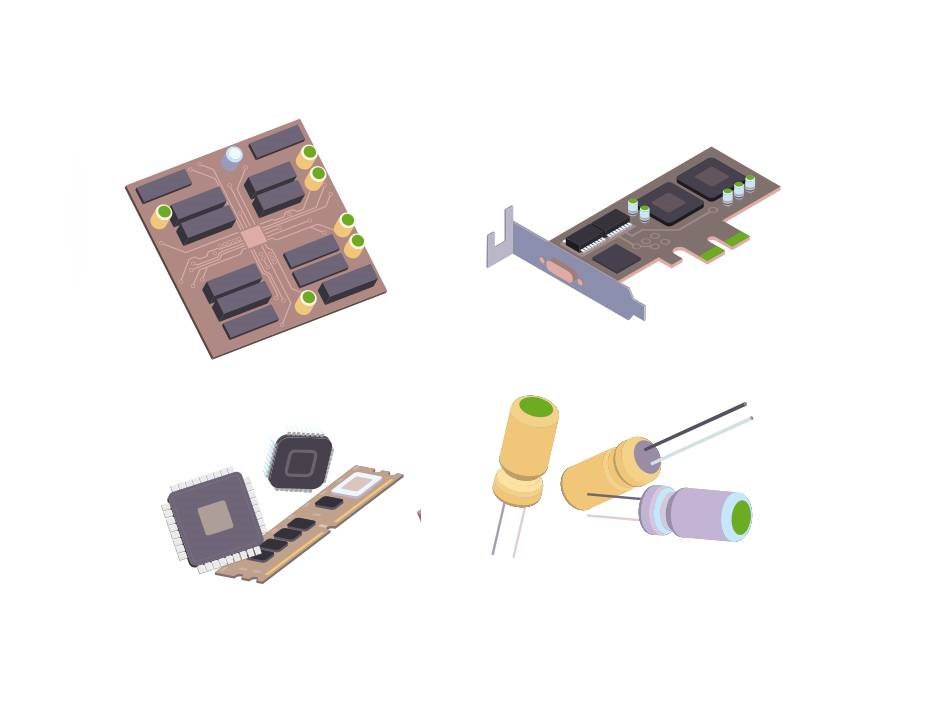From left: Annika Ramsköld, head of sustainability at Vattenfall and Josefin Levander, sustainable IT at Malmö City

Once again the Nordic IT buyers have united to deliver a powerful message to the global IT industry on how to accelerate the development toward more sustainable IT. This time the focus is on closing the loop on materials. Buyers say this is an important step for resource efficiency and circularity that can be taken right away, and they also see several opportunities for collaboration.
Main messages to the industry:
- Reach an industry-wide agreement on critical obstacles and incentives to close the loop on materials in the value chain. Invite stakeholders to a dialogue.
- Identify which materials are the most significant to close the loop on in order to maximize the sustainability impact.
- Define principles of a system for material recovery that is resource-, energy- and cost-efficient, while also mitigating social impact.
- Investigate and report on how different approaches to development and design of systems, products and services can affect the value of materials and the ability to recover them.
- Based on points 1–4, develop recommendations to buyers on how their actions can support the progress toward a circular and climate-neutral IT industry.

About the report
The ASF report 2020 demonstrates the most important sustainability aspect for the global IT industry according to the Nordic IT buyers. It is handed over to the Responsible Business Alliance, the industry’s sustainability organization. The report contains:
- Recommendations to the industry on how to close the loop on materials. The recommendations are developed by the ASF Advisory Board, a group of IT, sustainability and purchasing experts from leading Nordic organizations, based on the ASF dialogue survey.
- An industry analysis on the gaps between the IT buyers’ expectations and the industry’s current performance, conducted by Ethos International.
- Summary of the industry progress made on transparency and circular economy which were the themes of the first and the second ASF report.
”I’m impressed with the actions to assemble stakeholders to address the circular economy recommendations, and I have high expectations on the future collaboration to cover the whole industry.”
Why do we need to close the loop?
The appetite for materials is skyrocketing
The world is only 8,6 per cent circular, meaning that of all the minerals, fossil fuels, metals and biomass that enter it each year just 8.6 per cent are cycled back.
The consumption of materials has quadrupled since 1970, while the population has only doubled.
In the last two years, consumption has increased by more than eight per cent but the reuse of resources has fallen.
Production paved with problems
Around 70 percent of the carbon footprint from small it products come from the production.
The so called conflict minerals (tin, tantalum, tungsten and gold) on which electronic equipment is heavily dependant, fuel conflicts in DR Congo, with devastating consequences for miners and their families.
Complex supply chains with limited transparency increases the risks for violations of labor rights.
The production of one laptop requires 240 kilos of fossil fuels, 22 kilos of chemicals and 1,500 kilos of water. It generates 1,2 tons of waste.
From e-waste to e-source?
E-waste is the most rapidly growing waste stream predicted to reach 52 million tons in 2021.
Only about 20 per cent is properly recycled.
There is 17 times more gold in a ton of smartphones than in a ton of ore.
The estimated value of the world’s e-waste is 55 billion Euro.
Nordic IT buyers to the industry: Increase amount of recycled content

In the 2019 ASF dialogue, the foundation of the ASF report, 639 Nordic IT buyers gave their view on how to achieve a more circular IT industry.
What they as buyers can do (multiple choices possible)
- Use existing equipment longer (50 %)
- Purchase sustainability certified products (49 %)
- Increase withdrawals of used equipment (48 %)
What they want to see from the industry (multiple choices possible)
- Increase share of reclaimed material in new products (62 %)
- Design for prolonged lifetime (55 %)
- Minimize electronic waste (52 %)
Take action
Ok, so you have read a report and you think it has a point. Now what to do? Here are some suggestions on some steps you can take right away.
- If you haven’t already, share the report with someone in the industry or a fellow IT buyer
- Book a meeting where colleagues from IT, sustainability and purchasing discuss the ASF report
- Read more about how your business can give IT equipment a second life here (Swedish) or here (Finnish)
- Take a look at this guide and see how you can set effective sustainability requirements (in Swedish)
- Invite suppliers to a dialogue about how we can close the loop on IT materials
- Listen to a webinar on circular IT (in Swedish)
- Discuss the report with the global IT industry. Look here!
- Read the other ASF reports: Transparency and Circular Economy.

“There is a tremendous power in joining forces”

Once a year a dozen IT, sustainability and procurement experts – the ASF Advisory Board – gather for two days to develop recommendations to the global IT industry on how to address a certain urgent sustainability issue. Here, two of them, Annika Ramsköld, head of sustainability at Vattenfall, and Josefin Levander, sustainable IT at the City of Malmö, spill the beans on how the discussions went and what they hope to achieve.
A few months have passed since the Advisory Board meeting and ASF report, in which the recommendations are presented, is hot off the press when Annika and Josefin meet to discuss its findings.
Both of you participated in the Advisory Board for the first time. What are your reflections?
- Josefin: I thought it was very interesting with the different perspectives and competences that contributed.
- Annika: I agree. I was surprised how concrete the result was. We had sparkling discussions, ideas were tossed around, but we came to conclusions. We have all different backgrounds but the consensus around the essential aspects was very strong. So, two words: Surprised and impressed!
The focus of the report is closing the loop on materials. Why?
- Annika: We all know that digitization makes IT more and more important. At the same time devices contain sensitive minerals and a lot of plastics. Energy consumption is high and resources are finite. There are also a lot of social risks connected to the minerals. Companies have targets around their climate footprint and resource efficiency. IT is a big part of that but it is rarely talked about. Knowing all that, the issue of materials became very important.
- Josefin: Adding to that, the production is responsible for the majority of the CO2 emissions in an IT product’s lifecycle. . Our reasoning was that closing the loop on materials addresses all these sustainability aspects. Reduced need for raw materials means less pressure on the environment and social aspects.
- Annika: And then we had the underlying survey where 600+ IT buyers declared they want more recycled content and resource efficiency from the industry.
- Josefin: We discussed a lot whether we should focus on the climate issue or human rights and so on. Circularity embraces all of these aspects.
- Annika: Good point! Circularity became the uniting force.
In circular economy, prolonged lifespan is favored above recycling. Still you choose to focus on materials. How come?
- Annika: You need to design the products so that smaller components can be replaced. That was something we discussed a lot, for example if a laptop is constructed so that functionality can be upgraded while the majority of the material is kept intact, users can still stay up to speed with the technological advancements that drive demand today. So it is all connected. Prolonging lifespan is a way to minimize use of materials.
- Josefin: Also the fact that you need to be able to upgrade the software so that hardware isn’t replaced because of software-integration issues. This is something we often see in my organization.
- Josefin: We also talked about how this requires a change of business models. In today’s models manufacturers often lack incentives for prolonging the lifespan.
This year the Advisory Board put a lot of emphasis on involving the buyers. How come?
- Annika: First of all it’s a question of transparency and credibility. We as buyers want to know products’ footprint and if they’re manufactured responsibly. This can only be achieved through an open dialogue. But even more important is dialogue as a way of accelerating innovation by setting the right criteria. I have seen many examples where buyers set ambitious criteria that lead to nowhere or even contradict the purpose because of a lack of understanding of what impact the criteria has on the production process.
- Josefin: I can only agree. For public buyers when the tendering process starts the criteria are already set and few changes can be made. Through a dialogue with the industry we can achieve sharper and more relevant criteria that more actors can meet and by that move the industry bit by bit.
What is your most important message to someone you think should read the report?
- Josefin: This report contains concrete and useful information on what both you as a buyer and you as a supplier can do to transform to a more sustainable management of IT. I will give it to all my colleagues in procurement as inspiration.
- Annika: And to those outside of IT or purchasing I say: Read this report if you want to see how a few buyers, by uniting behind clearly defined demands, can affect a whole industry. There is a tremendous power in joining forces.
- Josefin: And the focus on dialogue between buyers and the industry makes this report special.
What do you want the report lead to?
- Annika: That the industry will sit down to find a way to become more circular, use materials more efficiently and be more innovative in their sustainability efforts. But also that we as buyers will understand what incentives we need to provide. Thirdly, that we through dialogue will set better criteria and that the industry will respond to that with better business models.
- Josefin: I hope it will lead to a closer collaboration between the industry and the buyers. That reaching out to a supplier between tendering periods will be a natural thing.
How do you think the industry has responded to the work of Atea Sustainability Focus so far?
- Annika: I am truly impressed by how the industry embraced the messages of the previous reports and how they have taken action, for example with the transparency guide that was a direct response to the first report. And also the fact that they really want a good dialogue.
- Josefin: We can see a lot happening even with products where it has been a bit uphill sustainability wise, so hopefully in a few years’ time we will have more sustainable products on the market and more services like repair and leasing of used equipment.
Any final message?
- Annika: Yes! Even if we are Lilliputians on a global scale we can drive change.
- Josefin: Exactly, when it comes to sustainability other countries look at the Nordics, but we at the City of Malmö could never have done this on our own.